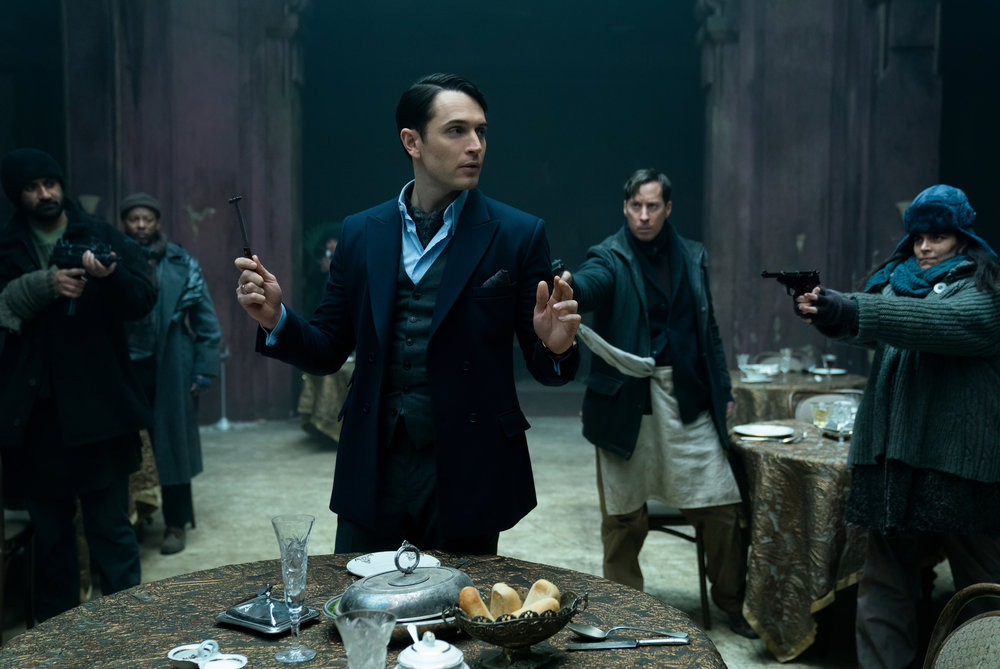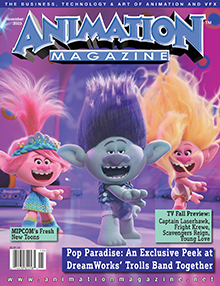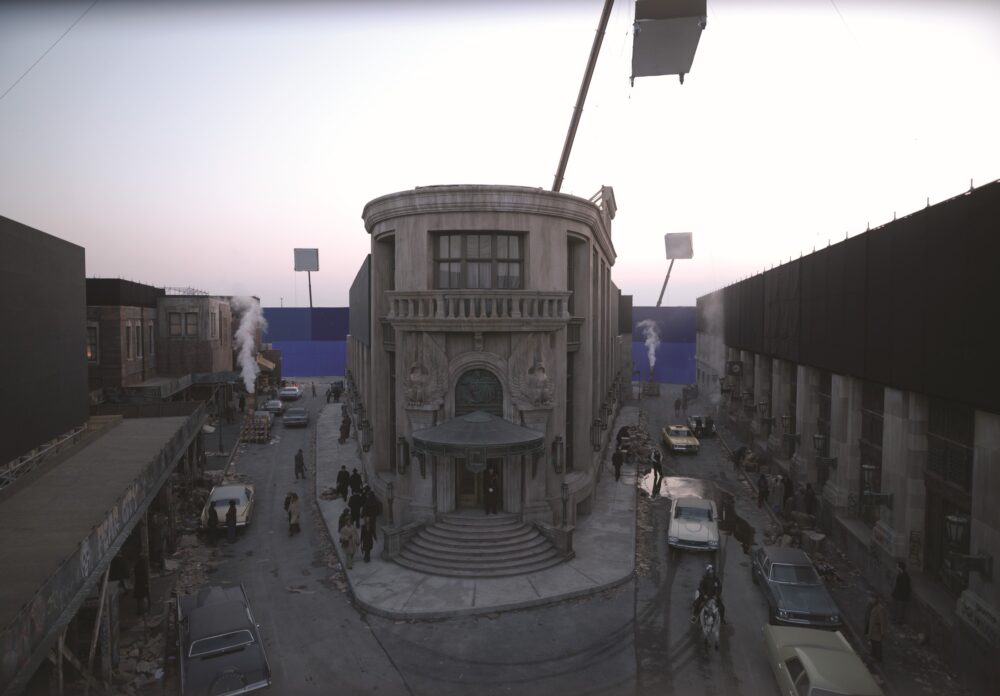|
Getting your Trinity Audio player ready...
|
This fall, Peacock viewers get a chance to explore the backstory of Winston Scott, the debonair hotelier from the popular John Wick franchise, in a three-part miniseries. Directed by Albert Hughes and Charlotte Brändström and written by Greg Coolidge, Kirk Ward, Shawn Simmons and Ken Kristensen, The Continental: From the World of John Wick stars Colin Woodell as the young version of Scott (the character made famous by Ian McShane in the John Wick films), as well as Mel Gibson, Hubert Point-Du Jour, Jessica Allain and Mishel Prada.
‘We focused on the numerous people who are going to be asking, ‘Does this New York feels like what I remember it being as a kid?’ Even though we played a little with the geography, the aim was not to go too far into an overly stylized world.’
— Visual effects supervisor John Decker
Those worried that the action and violence would be toned down for the small screen will be happy to know that bullets fly mercilessly, blood gushes freely and the body count keeps on multiplying in this show as well. Taking care of the project’s realistic visual effects is VFX supervisor John Decker, whose long list of credits includes For All Mankind, Inventing Anna and American Horror Story. “The show is set in the 1970s, which harkened back to the classic movie of the week and miniseries like The Winds of War, where you had these event evenings,” Decker points out.

Colin Woodell as Winston Scott in ‘The Continental: From the World of John Wick’ [ph: Katalin Vermes/Starz Entertainment]
The opening gunfight featuring Scott’s brother Frankie (Ben Robson) as he attempts to leave The Continental hotel after stealing a mysterious item is a well-choreographed ballet between stunts, special effects, camera and digital effects. “That sequence was meant to feel like one seamless take, but the cuts were well hidden within the action,” he notes. “Everyone went into the stairwell knowing what all the bits were going to be. Our work was classic guns from the John Wick menu card of muzzle flashes, bullet hits on the walls and people, and stunt rig removal for people who go flying.”
The miniseries’ bullet hits, muzzle flashes and blood splatters were all meticulously art directed. “Early on, Albert Hughes and I worked through a vocabulary of what he wanted. Albert didn’t want anything too over the top and that line moved a little one way or the other according to taste,” says Decker.
A serious “ouch” moment takes place when Yen (Nhung Kate), the martial arts proficient spouse of Frankie, shoves her attacker’s hand into a food waste disposal and turns it on. “All of that blood is visual effects. We definitely went through a few ranges of how much do we see splatter onto that tiled backsplash, and kept on going further and further. The digital artists did a great job because it feels wet and gooey, and the sound that goes along it helps a lot too! That’s one of those moments when you’re not thinking of visual effects when you watch it. You’re going ‘Ugh’ because it is so gut-wrenching.”
Lou (Jessica Allain), who runs a family dojo in Chinatown, gets to display her hand-to-hand combat skills in the back of a pickup truck. “Almost every outdoor setting that you see there is set extension work being done,” reveals Decker. “In that case, extending Chinatown and putting Greater New York up on the skyline. We’re touching most of those exteriors. For the fight itself, there were a lot of stunt mats and rigging for flips, jumps and spins that had to be removed. We worked with the stunt team to understand what they were planning and to figure out the camera positions.”
There were no digital doubles used in that sequence. “When you see Lou kicking and punching, that is Lou kicking and punching. Most of the actors were game to participate when they could,” explains the VFX supervisor.
The Continental diverts a bit from the slick, ultraviolent visual style established by the cinematic franchise. “That freed us to do what was appropriate for the style of these films and the time period that they’re set in which is more of that gritty French Connection verisimilitude,” says Decker. “For our part, we focused on the numerous people who are going to be asking, ‘Does this New York feels like what I remember it being as a kid?’ Even though we played a little with the geography, the aim was not to go too far into an overly stylized world.”

On the backlot of Origo Studios in Budapest, a three-story exterior of The Continental and a couple of city blocks were constructed based on concept art provided by production designer Drew Boughton. “We brought in the colors, tones and architectural elements of the concept art,” states Decker. “Albert would do a fair number of rough storyboards which were more to do with the camera. We had a lot of stuff from the art department that could be leveraged once we got into post and were exploring the world with the vendors.”
Bluescreen was placed at the end of backlot set. “Elements of people and cars were shot against bluescreen and populated out all the way down the streets to the vanishing point on the horizon.”
According to Decker, a week was spent shooting plates and reference of rooftops and water towers in New York City. “For the scrapyard where Charlie [Peter Greene] lives that has the RV underneath the Manhattan Bridge, we did go there and took notes of what you see and where the World Trade Center would have been. We also looked at several older movies from the 1970s where you can find what the skyline should look like and what were the general characteristics of the buildings.”
Interior sets did not require much in the way of visual effects. “In most cases we were putting Manhattan outside of windows, but for the most part the rooms themselves, such as Cormac’s office or the hallways, were practical sets that we shot on a stage or location.”
All three episodes were shot before going into postproduction which proved to be helpful when assembling the signature slow-motion shots. “That gave our editors a head start because even though we were still shooting they were actively cutting and working through all of those re-speeds and re-timings,” says Decker. “By the time we were going to turnover to our vendors, those re-speeds had been established, talked about, looked at and agreed upon.”
A ’70s Show
In total, 1,400 visual effects shots were created for the miniseries. “We tried to keep the vendor list relatively small and most of the set pieces were fairly self-contained,” says Decker. “Crafty Apes handled The Continental set extensions while Zoic Studios did Chinatown. Those assets could be developed and created separately because they did not have any interaction. Charlie’s scrapyard was Spin VFX and FuseFX did our Manhattan Bridge sequence in the first episode.”
Frankie, Winston and Yen escaping in a Mustang from Charlie’s scrapyard was one of the most complex scenes to execute in the whole project. As Decker details, “The street with the buildings was one plate that had to be shot with a camera high up on a crane. However, that set ended after 150 feet, so in order to get a plate of the car being 500 feet away, we had to shoot another plate on another night with a different camera and crane. Then the helicopter on the roof is a third set which was only about 10 feet off the ground on a different part of the lot. That was nerve-racking until we saw it all put together.”
In the end, the biggest challenge was trying to create a believable 1970s version of New York City. “Our goal was to make sure that the character of New York comes through so no one is thinking about where we shot it as they watch it,” says the VFX master. “I feel like we did it. There are a lot of shots that you would never believe that we did on a backlot once we dropped in all of our stuff.”
The Continental: From the World of John Wick is currently streaming on Peacock.
















 Win 'The Art of DreamWorks Dog Man'!
Win 'The Art of DreamWorks Dog Man'! 

